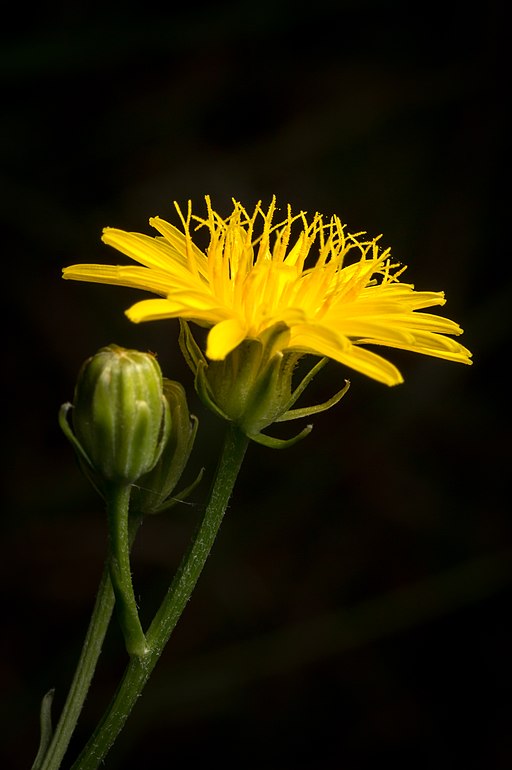Classification System: APG IV
Superregnum: Eukaryota
Regnum: Plantae
Cladus: Angiosperms
Cladus: Eudicots
Cladus: Core eudicots
Cladus: Asterids
Cladus: Campanulids
Ordo: Asterales
Familia: Asteraceae
Subfamilia: Cichorioideae
Tribus: Cichorieae
Subtribus: Crepidinae
Genus: Crepis
Species: Crepis vesicaria
Subspecies: C. v. subsp. andryaloides – C. v. subsp. bivonana – C. v. subsp. congenita – C. v. subsp. hyemalis – C. v. subsp. myriocephala – C. v. subsp. proleptica – C. v. subsp. stellata – C. v. subsp. taraxacifolia – C. v. subsp. vesicaria
Name
Crepis vesicaria L., 1753
References
Linnaeus, C. 1753. Species Plantarum. Tomus II: 805. Reference page.
Hassler, M. 2018. Crepis vesicaria. World Plants: Synonymic Checklists of the Vascular Plants of the World In: Roskovh, Y., Abucay, L., Orrell, T., Nicolson, D., Bailly, N., Kirk, P., Bourgoin, T., DeWalt, R.E., Decock, W., De Wever, A., Nieukerken, E. van, Zarucchi, J. & Penev, L., eds. 2018. Species 2000 & ITIS Catalogue of Life. Published on the internet. Accessed: 2018 May 22. Reference page.
International Plant Names Index. 2018. Crepis vesicaria. Published online. Accessed: May 22 2018.
The Plant List 2013. Crepis vesicaria in The Plant List Version 1.1. Published on the internet. Accessed: 2018 May 22.
Tropicos.org 2018. Crepis vesicaria. Missouri Botanical Garden. Published on the internet. Accessed: 2018 May 22.
USDA, ARS, Germplasm Resources Information Network. Crepis vesicaria in the Germplasm Resources Information Network (GRIN), U.S. Department of Agriculture Agricultural Research Service. Accessed: 07-Oct-06.
Crepis vesicaria is a European species of flowering plant in the daisy family with the common name beaked hawk's-beard.[2][3] It is native to the Western and Southern Europe from Ireland and Portugal east as far as Germany, Austria, and Greece.[3] It became naturalized in scattered locations in North America.[3][4]
Crepis vesicaria is an annual, biennial, or perennial herb up to 120 cm (48 inches or 4 feet) tall, producing a large underground caudex. Each plant can have as many as 20 flower heads, each with up to 70 ray florets but no disc florets. It grows on hillsides and in sandy clearings.[5]
A prominent plant, Crepis vesicaria stands erect, with many branches, each ending in its own dandelion-like flower.[6]
The underside of the flower has two layers of leaf-like phyllaries. The inner layer is longer and pointed, and often curls back away from the rest of the flower head. The outer layer is substantially shorter.[6]
Subspecies
Subspecies include:[1]
Crepis vesicaria subsp. andryaloides (Lowe) Babc.
Crepis vesicaria subsp. bivonana (Soldano & F.Conti) Giardina & Raimondo
Crepis vesicaria subsp. hyemalis (Biv.) Babc.
Crepis vesicaria subsp. myriocephala (Batt.) Babc.
Crepis vesicaria subsp. stellata (Ball) Babc.
Crepis vesicaria subsp. taraxacifolia (Thuill.) Thell.
Crepis vesicaria subsp. vesicaria
References
The Plant List, Crepis vesicaria L.
BSBI List 2007 (xls). Botanical Society of Britain and Ireland. Archived from the original (xls) on 2015-06-26. Retrieved 2014-10-17.
Altervista Flora Italiana, Radicchiella rosea, Beaked hawksbeard, Löwenzahn-Pippau, blåsfibbla, Crepis vesicaria L. includes photos and European distribution map
Biota of North America Program 2014 county distribution map
Flora of North America, Beaked hawksbeard Crepis vesicaria Linnaeus, Sp. Pl. 2: 805. 1753.
Jepson, Willis Linn (1909). A flora of California, by Willis Linn Jepson. San Francisco, Calif.: Cunningham, Curtis & Welch. doi:10.5962/bhl.title.7604.
Retrieved from "http://en.wikipedia.org/"
All text is available under the terms of the GNU Free Documentation License


